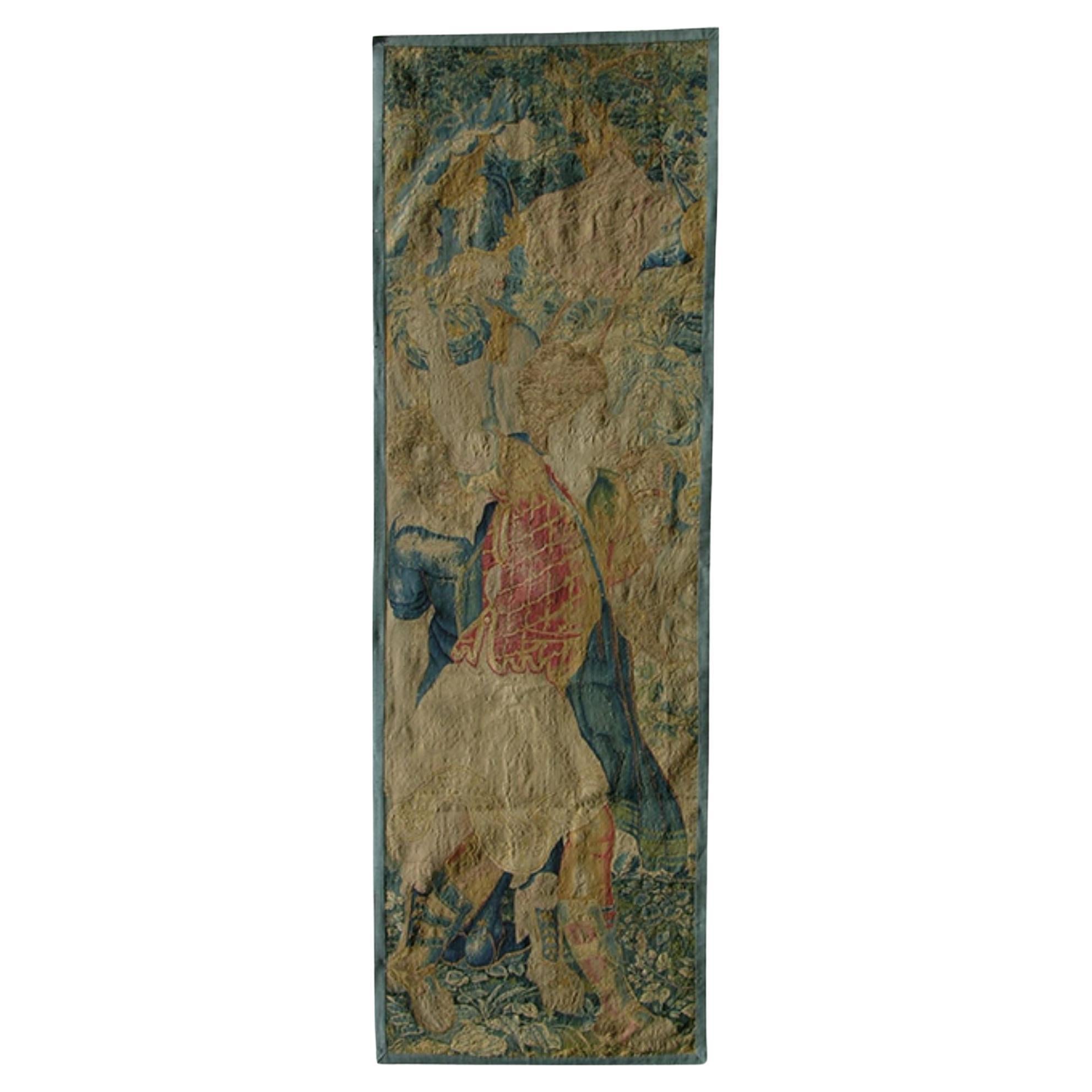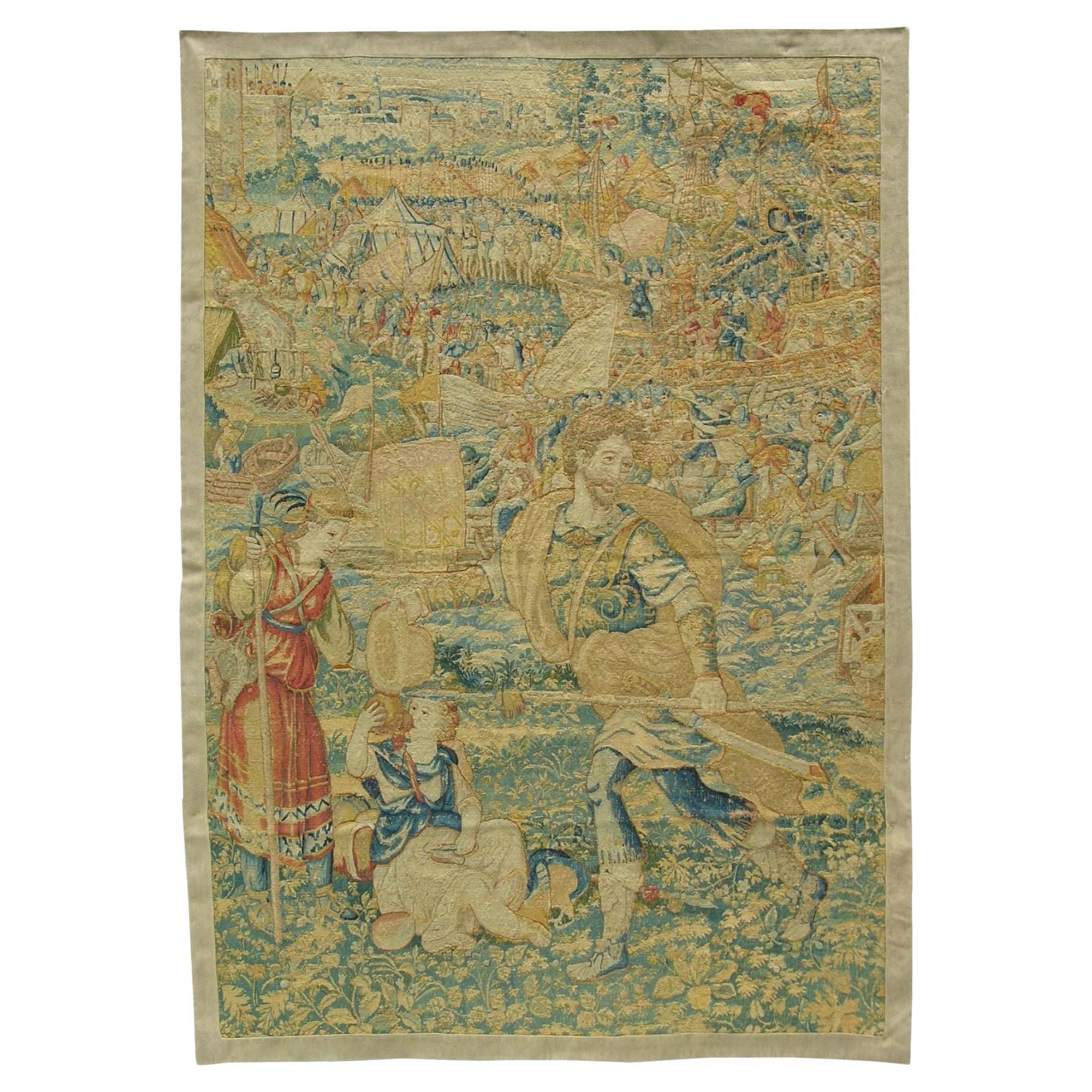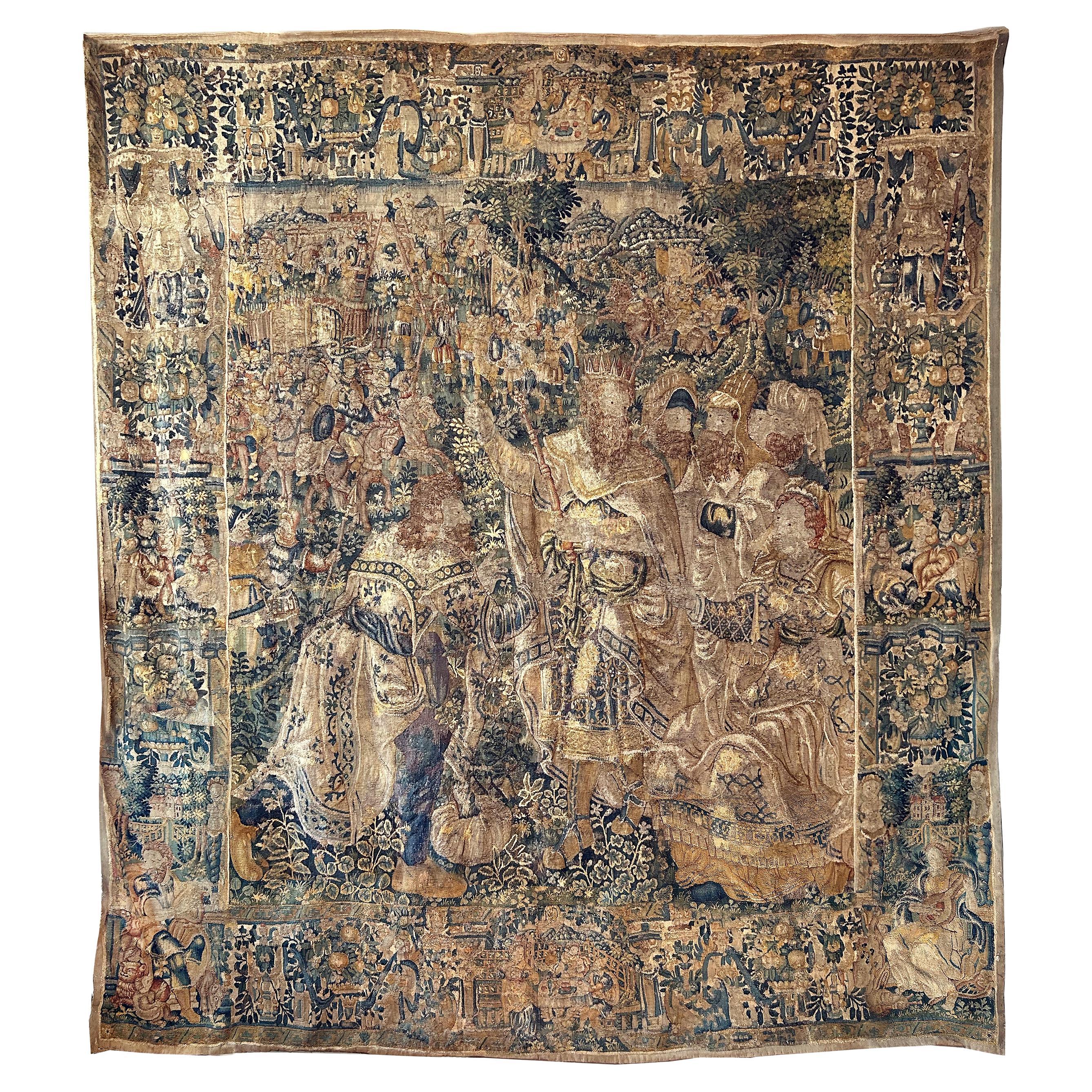Items Similar to 16th century Brussels tapestry - The Story of David
Want more images or videos?
Request additional images or videos from the seller
1 of 8
16th century Brussels tapestry - The Story of David
About the Item
16th century Brussels tapestry
The Story of David
Brabant, 16th Century
Monogram at the bottom left.
320 x 250 cm
This splendid Brussels tapestry, crafted from wool and silk during the 16th century, bears the monogram of the weaver's workshop at its lower left corner.
The tapestry narrates the story of David, with a particular focus on the episode of the young shepherd's battle against formidable adversaries: the lion and the bear. The Bible recounts David's struggle against Goliath, a tale pivotal in ending the war between the Philistines and the people of Israel. Within this narrative, the accounts of David's previous clashes with the lion and the bear are intricately woven.
The confrontation with Goliath stands as one of the most renowned episodes in the wars between Israel and the Philistines. Goliath, a giant standing at 9 feet 2 inches, hailing from the city of Gath, challenged the entire army of Israel to single combat for 40 days, with no one daring to face him. It was David, who, sidelined from the war due to his youth, volunteered to confront Goliath when he arrived to supply his brothers with provisions.
The central scene depicted in the tapestry portrays David's battle against the beasts, which aimed to persuade King Saul to allow him to face the giant despite his youth. The crux of this episode lies in the unwavering faith that fuels David and the divine protection that accounts for his remarkable victory. David, drawing a parallel, states, 'When your servant was tending his father's sheep and a lion or a bear would come and carry off a sheep from the flock, I would go after it, strike it, and rescue the sheep from its mouth. If it turned on me, I would seize it by the jaw, strike it, and kill it. Your servant has killed both the lion and the bear; this uncircumcised Philistine will be just like one of them, since he has defied the troops of the living God. David added, 'The Lord, who saved me from the paw of the lion and the paw of the bear, will save me from the hand of this Philistine.' So Saul said to David, 'Go, and may the Lord be with you.'
David, a shepherd under his father Jesse, was soon recognized as a representation of the Son of God, who became the Son of Man to manifest to humanity. David, the shepherd who risked his life to face the beasts and ensure the sheep's salvation, was an unmistakable figure of the Good Shepherd who 'lays down his life for his sheep.' The episode of David's triumph over the lion and the bear can be counted among the symbols of Christ's Paschal victory over Satan, rescuing humanity.
According to Hippolyte, the lion symbolizes death and the bear represents sin. From the Christological interpretation where David conquers the lion and the bear symbolizes Christ's triumph over infernal powers, one naturally transitions to a moral exegesis: just like David, Christians are called to conquer evil and sin.
The tapestry is framed within a beautiful and expansive border richly adorned with compartments. It is representative of many Brussels series from the third quarter of the 16th century, featuring the grotesque style popularized by Raphael's school in the first half of the 16th century, incorporating sphinxes, vases, flower garlands, and small colonnaded structures.
This exquisite decoration draws inspiration from the paintings found in the Domus Aurea (Golden House) discovered in Rome in 1493. Filled with animal allegories borrowed from late Antiquity treatises, such as those of Pliny, these images serve as allusions to the moral virtues illustrated in the central scene. The virtues showcased at the four corners of the tapestry are typical of the late 16th century and frequently appear in Brussels, Tournai, and Enghien workshops.
Four episodes from the story of David, integrated into the border, complete the iconographic program of the central scene. In the upper part of the tapestry, we find the scene where David decides to face Goliath armed only with a shepherd's staff and a flat stone, while the lower part portrays the death of the giant at the hands of young David. On the left, another scene depicts David at Saul's court, playing soothing music on his harp to alleviate the king's bouts of depression. On the opposite side, we see David journeying to the camp of the Israelites to deliver food to his brothers engaged in battle against the Philistines, and at this moment, he hears Goliath's challenge to send a champion to fight him. Saul offers David armor to confront the giant, but the young shepherd chooses to fight without armor, relying on the protection of God.
In addition to symbols of wealth and prestige, tapestries served functional purposes such as providing insulation for castle walls, covering openings and providing privacy in bedrooms.
European clientele in the 16th century, seeking to enhance their prestige, inherited medieval codes, particularly chivalrous ideals, and continued to commission significant tapestry works from workshops. While repetitive and decorative patterns like verdure or armorials persisted, historiated tapestries gained increasing interest. Their subjects often allowed for the portrayal of a character trait, virtue, or an episode from the patron's life.
By the early 16th century, the Netherlands was one of the unrivaled centres of tapestry production in Europe, with the majority of industry concentrated in Brussels (the kingdom of Belgium seceded from the Netherlands in 1830). During the second quarter of the sixteenth century, the volume of lucrative commissions from the foremost courts of Europe encouraged even greater specialization by Brussels cartoonists and weavers, leading to extraordinary technical and artistic achievements.
The Brussels weaving workshops enjoyed an international reputation due to their technical and artistic excellence. They were particularly admired for their ability to capture texture, light, shadow, and relief effects using threads of various colors, similar to the nuances in paintings.
Some Brussels craftsmen even relocated to various parts of Europe, often close to the monarchs' residences. Furthermore, renowned painters sent their designs to Brussels to be executed into tapestries.
Tapestry manufacturing was a highly organized and standardized business involving fine artists, weaver's guilds, large financiers, dealers and royal commissions.
The cost of labor and raw materials, including wool, silk, and gold threads, necessitated significant financial investments. These workshops were essentially enterprises managed by weaving dynasties. Consequently, Brussels' tapestries elevated the city's status as a stronghold in the European luxury market. These Brussels tapestries, whether used for devotion or as a medium for displaying power, found their way to numerous European courts.
From the Dukes of Brabant to the Dukes of Burgundy, and even the court of Emperor Charles V, Brussels fabric was highly sought-after during the transition from the Middle Ages to the Early Modern Period. It traveled as far as the court of the King of France and the Pope in Rome, from Cracow's castle to the London residences of Henry VIII. At the time, it was the most expensive prestige product in Europe.
The "movable frescoes of the North," as they were termed, held a prominent place in the grandeur of princely residences during this era.
- Dimensions:Height: 125.99 in (320 cm)Width: 98.43 in (250 cm)Depth: 0.2 in (5 mm)
- Style:Renaissance (Of the Period)
- Materials and Techniques:
- Place of Origin:
- Period:
- Date of Manufacture:16th century
- Condition:Rewoven. Wear consistent with age and use. Size has been slightly altered at the lower bottom border ; some rewoven in areas consistent with age (some old restaurations). Overall good conditions, the colors are still vivid.
- Seller Location:Bruxelles, BE
- Reference Number:1stDibs: LU6666236578522
About the Seller
5.0
Vetted Seller
These experienced sellers undergo a comprehensive evaluation by our team of in-house experts.
1stDibs seller since 2022
6 sales on 1stDibs
Typical response time: 7 hours
- ShippingRetrieving quote...Ships From: Bruxelles, Belgium
- Return PolicyA return for this item may be initiated within 3 days of delivery.
More From This SellerView All
- Massacre of the Innocents, Normandy, Late 16th CenturyLocated in Bruxelles, BEThe Massacre of the Innocents Carved oak panel Normandy, late 16th century (Collection labels on the back) Measures: 43,5 x 61 cm.Category
Antique 16th Century French Renaissance Wall-mounted Sculptures
MaterialsOak
- Group of Altarpiece - Antwerpen, 16th centuryLocated in Bruxelles, BEGroup of altarpiece representing the life of a Saint, Saint Renualde? Engraved by the sign of Antwerp hand on the hat of the central character Carved oak, traces of polychromy Fir...Category
Antique 16th Century Belgian Renaissance Figurative Sculptures
MaterialsOak
- Griffin Head, Italy, 16th CenturyLocated in Bruxelles, BEGriffin head Italy, 16th century On a modern metal stand Measures: 20 x 29 x 21 cm (without the stand) The griffin is a legendary creature with the body of a lion, the head an...Category
Antique 16th Century Italian Renaissance Animal Sculptures
MaterialsMarble
- Florentine Leather Casket, 16th CenturyLocated in Bruxelles, BEFlorentine leather casket Italy, Tuscany 16th century leather, iron and wood. Very rare boiled leather box incised on a wooden core; iron lock. The central shield is divide...Category
Antique 16th Century Italian Renaissance Decorative Boxes
MaterialsIron
- Bronze Mortar, Tuscany, Second Half of 16th CenturyLocated in Bruxelles, BEBronze mortar with garlands, flowers and putti - Tuscany , second half of 17th century. Measures: height 10 diameter : 13 cm Artisans and healers used mortars for grinding food...Category
Antique 16th Century Italian Renaissance Scientific Instruments
MaterialsBronze
- renaissance wooden candelabrum and painted cross - Umbria, 16th centuryLocated in Bruxelles, BEBase of a carved wooden candelabrum, polychrome and gilded; cross painted on both sides. Umbria or Tuscany, 16th century 136 x 43,5 x 30 cm (The cross and the base of the candelabrum were later assembled) The base of the candelabrum is intricately carved and adorned with polychrome and gilded finishes. The shafts take on the shape of balusters reminiscent of ancient columns, feature ornate foliage decorations, garlands and winged cherub faces. The feet are crafted in the likeness of lion paws. The base is further embellished with depictions of four saint martyrs, among them Saint Barbara and Saint Catherine of Alexandria. The plasticity of the figures, outlined with strong contour lines, the clear and vibrant colors, are stylistic elements linked to the Umbrian tradition of the sixteenth century.The precisely defined and elegant drawing, along with the clear color palette applied with refined chiaroscuro modulations, became the signature of a style that would leave a lasting mark on the era to come. This is exemplified by a preference for vibrant, multicolored images, accentuated in this case by the use of red and pink in the saint's attire. A notable addition, introduced later, is a polylobed cross painted on both sides. On one side, the Crucifixion is vividly portrayed:The treatment of the corpus itself is in line with High Medieval practice, emphasizing pathos by showing Jesus dead, his arms sagging from the weight of the body. The upper section displaying a pelican pecks at her breast to feed her young with her own blood; a symbol of the sacrifice of Christ on the cross whose body and blood similarly nourishes the celebrant during Mass. The lower part depicts Golgotha. On the reverse side, the Resurrection is artistically presented in a Renaissance iconography, reminiscent of the renowned composition painted by Piero della Francesca, now housed in the Civic Museum of Sansepolcro. In terms of composition, with the frontal depiction of Christ holding the banner, this motif became particularly widespread in central Italy, spanning from Tuscany to Umbria throughout the 16th century.. The double-sided construction suggests that it may also have been carried in liturgical processions. In Umbria from the 14th century, the use of portable crosses painted on both sides had become a widespread practice, aimed at satisfying the monastic clientele that had significantly increased following the establishment of new religious communities. The earliest surviving Tuscan painted crucifix represent Christ as Christus Triumphans, or the “Triumphant Christ” with his head up and eyes open. This form was supplanted in the 13th century with the Christus Patiens, or “Suffering Christ” type who is shown often with his head fallen on his shoulder and his eyes closed, as In our cross. The iconography of the suffering Christ appears to have developed out of a new interest in Christ’s human nature, the development of the feast of Corpus Christi and with increased importance given to the Eucharist. The process of humanizing the figure of Christ reaches its peak with the abandonment of all the previous expressive conventions in favor of more realistic details we can observe in this Crucifix, such as the swollen belly, the arms stretched to the limit of muscle tearing, the body falling heavily forward, the abundant blood on the wounds, and the cross firmly embedded in the rock of Calvary. It's worth noting that Renaissance candelabra...Category
Antique 16th Century Italian Renaissance Figurative Sculptures
MaterialsWood, Giltwood
You May Also Like
- Antique 16th Century Antique Brussels Tapestry with AngelLocated in New York, NYTapestries were ubiquitous in the castles and churches of the late medieval and Renaissance eras. At a practical level, they provided a form of insulation and decoration that could be easily transported. In addition, the process of tapestry weaving, where every stitch is placed by hand, enabled the creation of complex figurative images on an enormous scale. This 16th century antique brussels tapestry...Category
Antique 16th Century Belgian Renaissance Tapestries
MaterialsTapestry, Wool
- 16th Century Antique Brussels Tapestry 5'2" x 2'8"Located in Los Angeles, USA wall hanging tapestry, simply put, is a textile specifically designed and woven to portray an artistic scene with the intent of hanging it on a wall. Antique tapestries, those that...Category
Antique 16th Century Unknown Other Tapestries
MaterialsWool, Cotton
- 16th Century Antique Brussels Tapestry 10'2" X 3'3"Located in Los Angeles, USA wall hanging tapestry, simply put, is a textile specifically designed and woven to portray an artistic scene with the intent of hanging it on a wall. Antique tapestries, those that...Category
Antique 16th Century Unknown Other Tapestries
MaterialsWool, Cotton
- Antique 16th Century Brussels Tapestry 7'1" X 4'7"Located in Los Angeles, USA wall hanging tapestry, simply put, is a textile specifically designed and woven to portray an artistic scene with the intent of hanging it on a wall. Antique tapestries, those that...Category
Antique 16th Century Unknown Other Tapestries
MaterialsWool, Cotton
- 16th Century Antique Brussels Tapestry 7'4" X 5'4"Located in Los Angeles, USA wall hanging tapestry, simply put, is a textile specifically designed and woven to portray an artistic scene with the intent of hanging it on a wall. Antique tapestries, those that...Category
Antique 16th Century Unknown Other Tapestries
MaterialsWool, Cotton, Acrylic
- 16th Century Flemish TapestryLocated in Brooklyn, NYA magnificent Biblical tapestry in wool and silk likely made in the Flemish weaving center of Oudenaarde. With a history of tapestry production dating to 1368, the city created some of the finest tapestries of late Medieval and Renaissance Europe that were widely sought after across the continent. The 16th century...Category
Antique 16th Century Belgian Renaissance Tapestries
MaterialsWool, Silk





